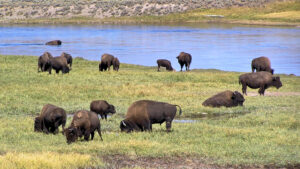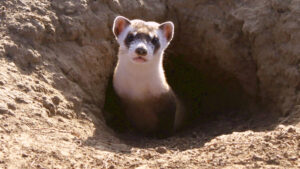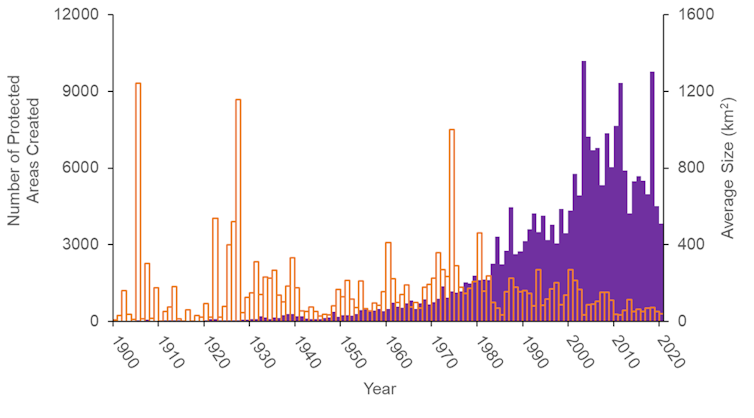By David Jachowski, Clemson University

Driving north on state Highway 66 through the Fort Belknap Indian Reservation in central Montana, it’s easy to miss a small herd of bison lounging just off the road behind an 8-foot fence. Each winter, heavy snows drive bison out of Wyoming’s Yellowstone National Park – the only place in the U.S. where they have lived continuously since prehistoric times – and into Montana, where they are either killed or shipped off to tribal lands to avoid conflict with cattle ranchers.
In the winter of 2022-2023 alone, over 1,500 bison have been “removed,” about 25% of Yellowstone’s entire population. The bison at Fort Belknap are refugees that have been trucked 300 miles to the reservation from past Yellowstone winter culls.
Although bison are the U.S. national mammal, they exist in small and fragmented populations across the West. The federal government is working to restore healthy wild bison populations, relying heavily on sovereign tribal lands to house them.

Indeed, tribal lands are the great wildlife refuges of the prairie. Fort Belknap is the only place in Montana where bison, critically endangered black-footed ferrets and swift foxes, which occupy about 40% of their historic range, all have been restored.
But Indigenous communities can’t and shouldn’t be solely responsible for restoring wildlife. As an ecologist who studies prairie ecosystems, I believe that conserving grassland wildlife in the U.S. Great Plains and elsewhere will require public and private organizations to work together to create new, larger protected areas where these species can roam.
Rethinking how protected areas are made
At a global scale, conservationists have done a remarkable job of conserving land, creating over 6,000 terrestrial protected areas per year over the past decade. But small has become the norm. The average size of newly created protected areas over that time frame is 23 square miles (60 square kilometers), down from 119 square miles (308 square kilometers) during the 1970s.

David Jachowski/Data from Protected Planet, CC BY-ND
Creating large new protected areas is hard. As the human population grows, fewer and fewer places are available to be set aside for conservation. But conserving large areas is important because it makes it possible to restore critical ecological processes like migration and to sustain populations of endangered wildlife like bison that need room to roam.
Creating an extensive protected area in the Great Plains is particularly difficult because this area was largely passed over when the U.S. national park system was created. But it’s becoming clear that it is possible to create large protected areas through nontraditional methods.
Consider American Prairie, a nonprofit that is working to stitch together public and tribal lands to create a Connecticut-sized protected area for grassland wildlife in Montana. Since 2004, American Prairie has made 37 land purchases and amassed a habitat base of 460,000 acres (about 720 square miles, or 1,865 square kilometers).
Similarly, in Australia, nonprofits are making staggering progress in conserving land while government agencies struggle with funding cuts and bureaucratic hurdles. Today, Australia is second only to the U.S. in its amount of land managed privately for conservation.
Big ideas make room for smaller actions
Having worked to conserve wildlife in this region for over 20 years, I have seen firsthand that by setting a sweeping goal of connecting 3.2 million acres (5,000 square miles, or 13,000 square kilometers), American Prairie has reframed the scale at which conservation success is measured in the Great Plains. By raising the bar for land protection, they have made other conservation organizations seem more moderate and created new opportunities for those groups.
One leading beneficiary is The Nature Conservancy, which owns the 60,000-acre Matador Ranch within the American Prairie focal area. When the conservancy first purchased the property, local ranchers were skeptical. But that skepticism has turned to support because the conservancy isn’t trying to create a protected area.
Instead, it uses the ranch as a grassbank – a place where ranchers can graze cattle at a low cost, and in return, pledge to follow wildlife-friendly practices on their own land, such as altering fences to allow migratory pronghorn to slip underneath. Via the grassbank, ranchers are now using these wildlife conservation techniques on an additional 240,000 acres of private property.
Other moderate conservation organizations are also working with ranchers. For example, this year the Bezos Earth Fund has contributed heavily to the National Fish and Wildlife Foundation’s annual grants program, helping to make a record $16 million available to reward ranchers for taking wildlife-friendly actions.
A collective model for achieving a large-scale protected area in the region has taken shape. American Prairie provides the vision and acts to link large tracts of protected land for restoring wildlife. Other organizations work with surrounding landowners to increase tolerance toward wildlife so those animals can move about more freely.
Instead of aiming to create a single polygon of protected land on a map, this new approach seeks to assemble a large protected area with diverse owners who all benefit from participating. Rather than excluding people, it integrates local communities to achieve large-scale conservation.
A global pathway to 30×30
This Montana example is not unique. In a recent study, colleagues and I found that when conservationists propose creating very large protected areas, they transform conservation discussions and draw in other organizations that together can achieve big results.
Many recent successes started with a single actor leading the charge. Perhaps the most notable example is the recently created Cook Islands Marine Park, also known as Marae Moana, which covers 735,000 square miles (1.9 million square kilometers) in the South Pacific. The reserve’s origin can be traced back to Kevin Iro, an outspoken former professional rugby player and member of the islands’ tourism board.
While some individual conservation organizations have found that this strategy works, global, national and local policymakers are not setting comparable large-scale targets as they discuss how to meet an ambitious worldwide goal of protecting 30% of the planet for wildlife by 2030. The 30×30 target was adopted by 190 countries at an international conference in 2022 on saving biodiversity.
Critics argue that large protected areas are too complicated to create and too expensive to maintain, or that they exclude local communities. However, new models show that there is a sustainable and inclusive way to move forward.
In my view, 30×30 policymakers should act boldly and include large protected area targets in current policies. Past experience shows that failing to do so will mean that future protected areas become smaller and smaller and ultimately fail to address Earth’s biodiversity crisis.![]()
David Jachowski is an associate professor of wildlife ecology at Clemson University.
This article is republished from The Conversation under a Creative Commons license. Read the original article.



